Posted on June 12, 2008 by toyotagarage
 Toyota Chaser is a mid-size 4 door sedan. In September 1996, the Toyota X100 Chaser replaced the Toyota X90 Chaser. By this time, the Chaser had become a more sporty sedan; for many, it was the definitive Chaser and the best-looking model. The product lineup consisted mostly of Avantes and Tourers, with the Avante as the luxury model (with more interior accessories) and the Toyota Tourer as the sporty model. Toyota’s VVTi, the company’s version of variable-valve timing, was added to the 1JZ engines; they were also upgraded to give out more torque, since they had already reached the legal limit set by Japanese authorities regarding horsepower. In 1997 the lineup remained largely unchanged, although a basic Toyota Tourer 2.0L model was added. The Toyota Tourer was powered by a 1G-FE engine, capable of 140 PS (138 hp/103 kW) at 5600 rpm. It was sold with only the 4-speed electronic control type (ECT) automatic transmission.
Toyota Chaser is a mid-size 4 door sedan. In September 1996, the Toyota X100 Chaser replaced the Toyota X90 Chaser. By this time, the Chaser had become a more sporty sedan; for many, it was the definitive Chaser and the best-looking model. The product lineup consisted mostly of Avantes and Tourers, with the Avante as the luxury model (with more interior accessories) and the Toyota Tourer as the sporty model. Toyota’s VVTi, the company’s version of variable-valve timing, was added to the 1JZ engines; they were also upgraded to give out more torque, since they had already reached the legal limit set by Japanese authorities regarding horsepower. In 1997 the lineup remained largely unchanged, although a basic Toyota Tourer 2.0L model was added. The Toyota Tourer was powered by a 1G-FE engine, capable of 140 PS (138 hp/103 kW) at 5600 rpm. It was sold with only the 4-speed electronic control type (ECT) automatic transmission.
Filed under: Autos, Buy A Car, Cars, Speed, Used Cars | Tagged: auto, Buy A Car, Cars, rent a car, technology, Used Cars | Leave a comment »
Posted on May 23, 2008 by toyotagarage
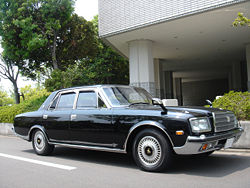 The Toyota Century is a large four-door limousine. The Toyota Century received a complete redesign in 1997, although the new model was visually very similar to the old. This current model is powered by a 280 PS (276 hp/206 kW) 5.0 L 1GZ-FE V12, initially with a 4-speed automatic, and then a 6-speed “intelligent” transmission. It also features air suspension and a factory LPG gas option, enabling the 2-ton car to be classed as a low emission vehicle. The Toyota Century remains the first and only Japanese front-engine, rear-wheel drive production car equipped with a V12. Like other cars in the top of the luxury class, the Century is designed with a chauffeur in mind. Hence, the rear seats recline and the front passenger seat has a fold-down center section so that a passenger in the back may stretch his feet forward. The rear seats are equipped with a massage system. The exterior door handles open the doors electrically since the sound of the door being opened mechanically is perceived as being “too obtrusive”. The doors of the Toyota Century do not need to be closed directly, instead the door only needs to contact the latch, causing the door to pull itself completely closed electrically.
The Toyota Century is a large four-door limousine. The Toyota Century received a complete redesign in 1997, although the new model was visually very similar to the old. This current model is powered by a 280 PS (276 hp/206 kW) 5.0 L 1GZ-FE V12, initially with a 4-speed automatic, and then a 6-speed “intelligent” transmission. It also features air suspension and a factory LPG gas option, enabling the 2-ton car to be classed as a low emission vehicle. The Toyota Century remains the first and only Japanese front-engine, rear-wheel drive production car equipped with a V12. Like other cars in the top of the luxury class, the Century is designed with a chauffeur in mind. Hence, the rear seats recline and the front passenger seat has a fold-down center section so that a passenger in the back may stretch his feet forward. The rear seats are equipped with a massage system. The exterior door handles open the doors electrically since the sound of the door being opened mechanically is perceived as being “too obtrusive”. The doors of the Toyota Century do not need to be closed directly, instead the door only needs to contact the latch, causing the door to pull itself completely closed electrically.
Filed under: Autos, Buy A Car, Cars, Speed, Used Cars | Tagged: auto, Buy A Car, Cars, rent a car, technology, Used Cars | 1 Comment »
Posted on April 16, 2008 by toyotagarage
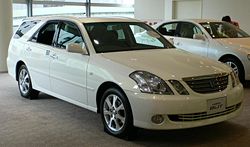 The Toyota Mark II found much success throughout its life as the definitive private-use executive car in Japan (the larger Toyota Crown was considered more of a chauffeur-driven car for upper management, and the Toyota Century is the flagship sedan on a presidential level). The Toyota Mark II and its variants often sold in numbers comparable to the smaller Toyota Corona and Toyota Corolla. Popularity peaked in the 1980s and the Toyota Mark II was available with engines ranging from a 1.8 liter 4-cylinder to a turbocharged 2.5-liter than pushed the 280 horsepower (209 kW) self-imposed limit of the Japanese auto industry. Like the first-generation Corolla in 1966, the Mark II would come to symbolize Toyota’s winning formula of capturing its customer’s upward aspirations through excellent perceived quality. In the late 90’s, the Mark II design slightly changed once more. Becoming increasingly popular among auto enthusiasts in the mid 90’s, Toyota went for a more aggressive approach. Couple with a powerful engine and solid chassis, the Toyota Mark II is a formidable platform for a fast car. The JZX90 and JZX100 chassis had the optional Tourer V model. The Tourer V had a reinforced body, sport suspension, stronger drivetrain, and a turbo 2.5 liter inline 6 engine know as the 1JZ-GTE. It came from the factory with 280 horsepower and optional 5-speed transmission. The 1JZ-GTE engine is very easily upgradeable and with very little money, 330hp was easily attainable.
The Toyota Mark II found much success throughout its life as the definitive private-use executive car in Japan (the larger Toyota Crown was considered more of a chauffeur-driven car for upper management, and the Toyota Century is the flagship sedan on a presidential level). The Toyota Mark II and its variants often sold in numbers comparable to the smaller Toyota Corona and Toyota Corolla. Popularity peaked in the 1980s and the Toyota Mark II was available with engines ranging from a 1.8 liter 4-cylinder to a turbocharged 2.5-liter than pushed the 280 horsepower (209 kW) self-imposed limit of the Japanese auto industry. Like the first-generation Corolla in 1966, the Mark II would come to symbolize Toyota’s winning formula of capturing its customer’s upward aspirations through excellent perceived quality. In the late 90’s, the Mark II design slightly changed once more. Becoming increasingly popular among auto enthusiasts in the mid 90’s, Toyota went for a more aggressive approach. Couple with a powerful engine and solid chassis, the Toyota Mark II is a formidable platform for a fast car. The JZX90 and JZX100 chassis had the optional Tourer V model. The Tourer V had a reinforced body, sport suspension, stronger drivetrain, and a turbo 2.5 liter inline 6 engine know as the 1JZ-GTE. It came from the factory with 280 horsepower and optional 5-speed transmission. The 1JZ-GTE engine is very easily upgradeable and with very little money, 330hp was easily attainable.
Filed under: Autos, Buy A Car, Cars, Speed, Used Cars | Tagged: auto, Buy A Car, Cars, rent a car, technology, Used Cars | Leave a comment »
Posted on March 18, 2008 by toyotagarage
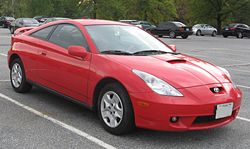 The Toyota Celica came in two different models. The ZZT230 powered by an economical 1.8 L 4-cylinder 140 hp 1ZZ-FE engine and the ZZT231 powered by a higher-performance 1.8 L 4-cylinder 191 hp in Europe and Japan (180 hp) 2ZZ-GE version, co-developed with Yamaha. Both of these engines featured Toyota’s signature VVT-i (Variable Valve Timing with Intelligence) system, which continuously varies the camshaft timing. In the USA and Canada the base model with 1ZZ-FE engine is called GT, and the higher performance model with 2ZZ-GE engine is GT-S. The GT-S had a more extensive and advanced system called VVTL-i (Variable Valve Timing with Lift and Intelligence), which is similar to the VVT-i except until 6100 rpm, when maximum intake valve lift is increased a fraction further to provide an increase in top-end power, accounting for the 41 hp difference. The GT was available in both a 5-speed manual and 4-speed automatic and the GT-S was available with a close-ratio 6-speed manual and a 4-speed manually shiftable torque converter automatic by Tiptronic. The Toyota Celica enjoyed the spotlight for about a year or so, being that it was one of the few vehicles offering 100 hp/L for under $27,000 USD. Unfortunately, Toyota was too late to the sport compact party in 2001, Honda released its Integra replacement, the Acura RSX for the 2002 model year, the Type-S model with a 2.0 L 4-cylinder 200 hp engine, which competed directly with the Toyota Celica GT-S. In 2004, for the 2005 model year, the RSX Type-S raised the hp to 210.
The Toyota Celica came in two different models. The ZZT230 powered by an economical 1.8 L 4-cylinder 140 hp 1ZZ-FE engine and the ZZT231 powered by a higher-performance 1.8 L 4-cylinder 191 hp in Europe and Japan (180 hp) 2ZZ-GE version, co-developed with Yamaha. Both of these engines featured Toyota’s signature VVT-i (Variable Valve Timing with Intelligence) system, which continuously varies the camshaft timing. In the USA and Canada the base model with 1ZZ-FE engine is called GT, and the higher performance model with 2ZZ-GE engine is GT-S. The GT-S had a more extensive and advanced system called VVTL-i (Variable Valve Timing with Lift and Intelligence), which is similar to the VVT-i except until 6100 rpm, when maximum intake valve lift is increased a fraction further to provide an increase in top-end power, accounting for the 41 hp difference. The GT was available in both a 5-speed manual and 4-speed automatic and the GT-S was available with a close-ratio 6-speed manual and a 4-speed manually shiftable torque converter automatic by Tiptronic. The Toyota Celica enjoyed the spotlight for about a year or so, being that it was one of the few vehicles offering 100 hp/L for under $27,000 USD. Unfortunately, Toyota was too late to the sport compact party in 2001, Honda released its Integra replacement, the Acura RSX for the 2002 model year, the Type-S model with a 2.0 L 4-cylinder 200 hp engine, which competed directly with the Toyota Celica GT-S. In 2004, for the 2005 model year, the RSX Type-S raised the hp to 210.
Filed under: Autos, Buy A Car, Cars, Speed, Used Cars | Tagged: auto, Buy A Car, Cars, rent a car, technology, Used Cars | Leave a comment »
Posted on March 18, 2008 by toyotagarage
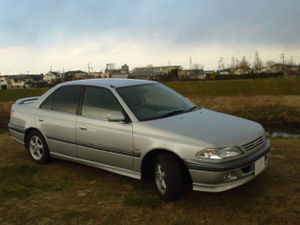 The first-generation Toyota Carina was launched in 1970 as a four-door companion to the Toyota Celica. Over time it became a sister car to the Toyota Corona, but while based on the same underpinnings, it was usually sportier with body work and interior completely separate from the Corona and aimed towards the younger buyers – it generally filled a gap between the Corolla and Corona models. This pattern would continue all the way until today – The Toyota Carina’s position relative to the Corona is identical to the Allion’s position relative to the Premio, which replaced the Corona. At the ED’s redesign in 1989 a sister car was introduced as the Corona Exiv. In 1992 Toyota would repeat the product planning on a Corolla-based hardtop, the Sprinter Marino and Corolla Ceres. In 1993 the ED/Exiv were redesigned alongside the Celica (gaining styling incredibly similar to the larger Toyota JZX90 Mark II), and that was the last iteration of the nameplates.
The first-generation Toyota Carina was launched in 1970 as a four-door companion to the Toyota Celica. Over time it became a sister car to the Toyota Corona, but while based on the same underpinnings, it was usually sportier with body work and interior completely separate from the Corona and aimed towards the younger buyers – it generally filled a gap between the Corolla and Corona models. This pattern would continue all the way until today – The Toyota Carina’s position relative to the Corona is identical to the Allion’s position relative to the Premio, which replaced the Corona. At the ED’s redesign in 1989 a sister car was introduced as the Corona Exiv. In 1992 Toyota would repeat the product planning on a Corolla-based hardtop, the Sprinter Marino and Corolla Ceres. In 1993 the ED/Exiv were redesigned alongside the Celica (gaining styling incredibly similar to the larger Toyota JZX90 Mark II), and that was the last iteration of the nameplates.
Filed under: Autos, Buy A Car, Cars, Speed, Used Cars | Tagged: auto, Buy A Car, Cars, rent a car, technology, Used Cars | Leave a comment »
Posted on March 18, 2008 by toyotagarage
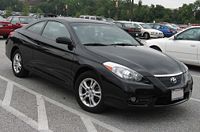 The second generation of the Toyota Camry Solara was completely redesigned and introduced to the public in 2004 and featured a more curvy body, with the option of adding XM radio and/or a navigation system. The Gen 2 body is also heavier than the Gen 1.5 body. The 4 cylinder is a carryover of the first mid generation’s engine, and the larger available engine was the new 3.3 L V6 rated at 225 net HP @ 5600 rpm (168 kW) and 240 lb·ft (325 N·m) of torque @ 3600 rpm (325 Nm) with a 0-60 of 6.9 seconds, with a quarter mile of 15.50 @ 93.50 mph (150.47 km/h). With the four-cylinder engine you could choose a five-speed manual or four-speed automatic transmission, while the V6 was matched to only a five-speed automatic transmission equipped with a sequential automatic, also known as a Multi-Mode Transmission (MMT). Both engines now feature Toyota’s VVT-i technology. The Toyota Camry Solara also moved to TMMK for the second generation model. Although it gained a slightly updated appearance, it still retained both engines. Due to the new SAE-Certified testing method, the 4-cylinder model is rated at 155 hp (116 kW) with 158 lb·ft (214 N·m) of torque (214 Nm), and the V6 is rated at 210 hp (157 kW) and 220 lb·ft (298 N·m) of torque (298 Nm), but the output and performance is still the same without mechanical change.
The second generation of the Toyota Camry Solara was completely redesigned and introduced to the public in 2004 and featured a more curvy body, with the option of adding XM radio and/or a navigation system. The Gen 2 body is also heavier than the Gen 1.5 body. The 4 cylinder is a carryover of the first mid generation’s engine, and the larger available engine was the new 3.3 L V6 rated at 225 net HP @ 5600 rpm (168 kW) and 240 lb·ft (325 N·m) of torque @ 3600 rpm (325 Nm) with a 0-60 of 6.9 seconds, with a quarter mile of 15.50 @ 93.50 mph (150.47 km/h). With the four-cylinder engine you could choose a five-speed manual or four-speed automatic transmission, while the V6 was matched to only a five-speed automatic transmission equipped with a sequential automatic, also known as a Multi-Mode Transmission (MMT). Both engines now feature Toyota’s VVT-i technology. The Toyota Camry Solara also moved to TMMK for the second generation model. Although it gained a slightly updated appearance, it still retained both engines. Due to the new SAE-Certified testing method, the 4-cylinder model is rated at 155 hp (116 kW) with 158 lb·ft (214 N·m) of torque (214 Nm), and the V6 is rated at 210 hp (157 kW) and 220 lb·ft (298 N·m) of torque (298 Nm), but the output and performance is still the same without mechanical change.
Filed under: Autos, Buy A Car, Cars, Speed, Used Cars | Tagged: auto, Buy A Car, Cars, rent a car, technology, Used Cars | Leave a comment »
Posted on March 18, 2008 by toyotagarage
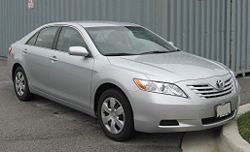 The sixth generation Toyota Camry went on sale in March 2006. It was significantly redesigned, with a 56 mm longer wheelbase, but the overall length remained the same. It was introduced at the 2006 North American International Auto Show alongside a hybrid version. The sixth generation Toyota Camry sold in some countries in Asia and the Middle East have different exterior body parts and a similar interior to the Camry depicted. The National Highway Traffic Safety Administration (NHTSA) gave the 2007 Toyota Camry and the Camry Hybrid a five-star safety rating for frontal crashes for both driver and passenger. Both models also received a five-star safety rating for side impact crashes for driver and passenger. The Camry received a four-star safety rating for rollovers. The Camry Hybrid was not tested for rollovers. The sixth generation model Toyota Camry received a four-star safety rating as a result of Australasian New Car Assessment Program (ANCAP) testing. Consumer Reports 2007 Annual Car Reliability Survey gave the V6 version of the Toyota Camry a “below average” rating, thus removing the V6 Camry from Consumer Reports’ “Recommended” list. This rating does not apply to the four cylinder and hybrid versions, which continued to be recommended.
The sixth generation Toyota Camry went on sale in March 2006. It was significantly redesigned, with a 56 mm longer wheelbase, but the overall length remained the same. It was introduced at the 2006 North American International Auto Show alongside a hybrid version. The sixth generation Toyota Camry sold in some countries in Asia and the Middle East have different exterior body parts and a similar interior to the Camry depicted. The National Highway Traffic Safety Administration (NHTSA) gave the 2007 Toyota Camry and the Camry Hybrid a five-star safety rating for frontal crashes for both driver and passenger. Both models also received a five-star safety rating for side impact crashes for driver and passenger. The Camry received a four-star safety rating for rollovers. The Camry Hybrid was not tested for rollovers. The sixth generation model Toyota Camry received a four-star safety rating as a result of Australasian New Car Assessment Program (ANCAP) testing. Consumer Reports 2007 Annual Car Reliability Survey gave the V6 version of the Toyota Camry a “below average” rating, thus removing the V6 Camry from Consumer Reports’ “Recommended” list. This rating does not apply to the four cylinder and hybrid versions, which continued to be recommended.
Filed under: Autos, Buy A Car, Cars, Speed, Used Cars | Tagged: auto, Buy A Car, Cars, rent a car, technology, Used Cars | Leave a comment »
Posted on March 18, 2008 by toyotagarage
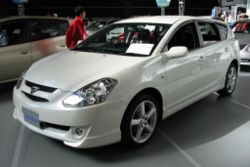 The all-new Toyota Caldina of September 2002 is a pure sports wagon, and does not share body panels with Allion, Premio, and Avensis. Engines for the Toyota Caldina are 1.8 L 1ZZ-FE, 2.0 L 1AZ-FE, or 2.0 L turbo 3S-GTE. Trim levels are 1.8 X, 1.8 Z, 2.0 Z, 2.0 ZT, and 2.0 GT-Four (the later is coded ST246). All models have automatic transmission. Minor refresh was given in January 2005. With the discontinuation of Celica, the Toyota Caldina was one of sportiest Toyota models sold in Japan. Caldina GT4 is also widely available as imported recondition cars in Malaysia. Production of the 3rd generation Toyota Caldina ended in 2007. That was also the end for both the renowned 3S-GTE engine and the legendary “GT-Four” moniker in Toyota’s lineup.
The all-new Toyota Caldina of September 2002 is a pure sports wagon, and does not share body panels with Allion, Premio, and Avensis. Engines for the Toyota Caldina are 1.8 L 1ZZ-FE, 2.0 L 1AZ-FE, or 2.0 L turbo 3S-GTE. Trim levels are 1.8 X, 1.8 Z, 2.0 Z, 2.0 ZT, and 2.0 GT-Four (the later is coded ST246). All models have automatic transmission. Minor refresh was given in January 2005. With the discontinuation of Celica, the Toyota Caldina was one of sportiest Toyota models sold in Japan. Caldina GT4 is also widely available as imported recondition cars in Malaysia. Production of the 3rd generation Toyota Caldina ended in 2007. That was also the end for both the renowned 3S-GTE engine and the legendary “GT-Four” moniker in Toyota’s lineup.
Filed under: Autos, Buy A Car, Cars, Speed, Used Cars | Tagged: auto, Buy A Car, Cars, rent a car, technology, Used Cars | Leave a comment »
Posted on February 15, 2008 by toyotagarage
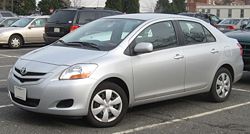 The Toyota Belta (referred to in North American and Australian markets as the Toyota Yaris Sedan) or Toyota Vios in Southasian markets is a subcompact sedan and hatchback manufactured by the Toyota Motor Corporation. It is basically a redesigned and sportier version of the discontinued Toyota Platz, and is similar to the Toyota Vitz. The Canadian version of the Yaris sedan, which is simply called the Yaris, is based on the American Yaris S with power and all-weather guard packages, but with standard 14 inch wheels. Option packages comes in one of B, C, D, or Aero packages. The B adds 15 inch all-season tires, chrome trim on the decklid, front and rear splash guards, color-keyed door handles, blacked-out side window frames, keyless entry and power door locks; the C adds ABS, air conditioning, power windows, color-keyed mirrors and power mirrors; the D adds both side and side-curtain airbags; the Aero adds aluminum alloy wheels, wheel locks, a rear spoiler, and a body kit. The Aero, however, has neither air conditioning nor side airbags. The Canadian model lacks the two-tone interior, pseudo-metallic trim on the door panels, and the new audio system controls (instead it uses an old design) found on the Japanese and American models.
The Toyota Belta (referred to in North American and Australian markets as the Toyota Yaris Sedan) or Toyota Vios in Southasian markets is a subcompact sedan and hatchback manufactured by the Toyota Motor Corporation. It is basically a redesigned and sportier version of the discontinued Toyota Platz, and is similar to the Toyota Vitz. The Canadian version of the Yaris sedan, which is simply called the Yaris, is based on the American Yaris S with power and all-weather guard packages, but with standard 14 inch wheels. Option packages comes in one of B, C, D, or Aero packages. The B adds 15 inch all-season tires, chrome trim on the decklid, front and rear splash guards, color-keyed door handles, blacked-out side window frames, keyless entry and power door locks; the C adds ABS, air conditioning, power windows, color-keyed mirrors and power mirrors; the D adds both side and side-curtain airbags; the Aero adds aluminum alloy wheels, wheel locks, a rear spoiler, and a body kit. The Aero, however, has neither air conditioning nor side airbags. The Canadian model lacks the two-tone interior, pseudo-metallic trim on the door panels, and the new audio system controls (instead it uses an old design) found on the Japanese and American models.
Filed under: Autos, Buy A Car, Cars, Speed, Used Cars | Tagged: auto, Buy A Car, Cars, rent a car, technology, Used Cars | Leave a comment »
Posted on February 15, 2008 by toyotagarage
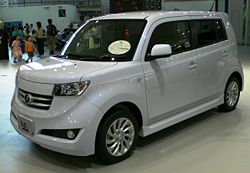 The Toyota bB is a small wagon produced by the Toyota Motor Corporation based on the Toyota Vitz. 1.3 L and 1.5 L I4 engines are available. While the box-shaped car was initially targeted towards Japanese men in their twenties, it is also popular with women buyers as well. It was introduced in 2000, and in 2001, a model called bB open deck was released. It had an open deck that made it like a pickup car, similar to the Subaru Baja. The 2nd generation bB was introduced as the music player in Dec 2005 and is equipped with 109hp 1.5L (Z Model) 3SZ-VE VVT-i engine or 92hp 1.3L (S Model) K3-VE VVT-i engine. 4WD is optional.
The Toyota bB is a small wagon produced by the Toyota Motor Corporation based on the Toyota Vitz. 1.3 L and 1.5 L I4 engines are available. While the box-shaped car was initially targeted towards Japanese men in their twenties, it is also popular with women buyers as well. It was introduced in 2000, and in 2001, a model called bB open deck was released. It had an open deck that made it like a pickup car, similar to the Subaru Baja. The 2nd generation bB was introduced as the music player in Dec 2005 and is equipped with 109hp 1.5L (Z Model) 3SZ-VE VVT-i engine or 92hp 1.3L (S Model) K3-VE VVT-i engine. 4WD is optional.
Filed under: Autos, Buy A Car, Cars, Speed, Used Cars | Tagged: auto, Buy A Car, Cars, rent a car, technology, Used Cars | 1 Comment »
 Toyota Chaser is a mid-size 4 door sedan. In September 1996, the Toyota X100 Chaser replaced the Toyota X90 Chaser. By this time, the Chaser had become a more sporty sedan; for many, it was the definitive Chaser and the best-looking model. The product lineup consisted mostly of Avantes and Tourers, with the Avante as the luxury model (with more interior accessories) and the Toyota Tourer as the sporty model. Toyota’s VVTi, the company’s version of variable-valve timing, was added to the 1JZ engines; they were also upgraded to give out more torque, since they had already reached the legal limit set by Japanese authorities regarding horsepower. In 1997 the lineup remained largely unchanged, although a basic Toyota Tourer 2.0L model was added. The Toyota Tourer was powered by a 1G-FE engine, capable of 140 PS (138 hp/103 kW) at 5600 rpm. It was sold with only the 4-speed electronic control type (ECT) automatic transmission.
Toyota Chaser is a mid-size 4 door sedan. In September 1996, the Toyota X100 Chaser replaced the Toyota X90 Chaser. By this time, the Chaser had become a more sporty sedan; for many, it was the definitive Chaser and the best-looking model. The product lineup consisted mostly of Avantes and Tourers, with the Avante as the luxury model (with more interior accessories) and the Toyota Tourer as the sporty model. Toyota’s VVTi, the company’s version of variable-valve timing, was added to the 1JZ engines; they were also upgraded to give out more torque, since they had already reached the legal limit set by Japanese authorities regarding horsepower. In 1997 the lineup remained largely unchanged, although a basic Toyota Tourer 2.0L model was added. The Toyota Tourer was powered by a 1G-FE engine, capable of 140 PS (138 hp/103 kW) at 5600 rpm. It was sold with only the 4-speed electronic control type (ECT) automatic transmission.

 The Toyota Century is a large four-door limousine. The Toyota Century received a complete redesign in 1997, although the new model was visually very similar to the old. This current model is powered by a 280 PS (276 hp/206 kW) 5.0 L 1GZ-FE V12, initially with a 4-speed automatic, and then a 6-speed “intelligent” transmission. It also features air suspension and a factory LPG gas option, enabling the 2-ton car to be classed as a low emission vehicle. The Toyota Century remains the first and only Japanese front-engine, rear-wheel drive production car equipped with a V12. Like other cars in the top of the luxury class, the Century is designed with a chauffeur in mind. Hence, the rear seats recline and the front passenger seat has a fold-down center section so that a passenger in the back may stretch his feet forward. The rear seats are equipped with a massage system. The exterior door handles open the doors electrically since the sound of the door being opened mechanically is perceived as being “too obtrusive”. The doors of the Toyota Century do not need to be closed directly, instead the door only needs to contact the latch, causing the door to pull itself completely closed electrically.
The Toyota Century is a large four-door limousine. The Toyota Century received a complete redesign in 1997, although the new model was visually very similar to the old. This current model is powered by a 280 PS (276 hp/206 kW) 5.0 L 1GZ-FE V12, initially with a 4-speed automatic, and then a 6-speed “intelligent” transmission. It also features air suspension and a factory LPG gas option, enabling the 2-ton car to be classed as a low emission vehicle. The Toyota Century remains the first and only Japanese front-engine, rear-wheel drive production car equipped with a V12. Like other cars in the top of the luxury class, the Century is designed with a chauffeur in mind. Hence, the rear seats recline and the front passenger seat has a fold-down center section so that a passenger in the back may stretch his feet forward. The rear seats are equipped with a massage system. The exterior door handles open the doors electrically since the sound of the door being opened mechanically is perceived as being “too obtrusive”. The doors of the Toyota Century do not need to be closed directly, instead the door only needs to contact the latch, causing the door to pull itself completely closed electrically. The Toyota Mark II found much success throughout its life as the definitive private-use executive car in Japan (the larger Toyota Crown was considered more of a chauffeur-driven car for upper management, and the Toyota Century is the flagship sedan on a presidential level). The Toyota Mark II and its variants often sold in numbers comparable to the smaller Toyota Corona and Toyota Corolla. Popularity peaked in the 1980s and the Toyota Mark II was available with engines ranging from a 1.8 liter 4-cylinder to a turbocharged 2.5-liter than pushed the 280 horsepower (209 kW) self-imposed limit of the Japanese auto industry. Like the first-generation Corolla in 1966, the Mark II would come to symbolize Toyota’s winning formula of capturing its customer’s upward aspirations through excellent perceived quality. In the late 90’s, the Mark II design slightly changed once more. Becoming increasingly popular among auto enthusiasts in the mid 90’s, Toyota went for a more aggressive approach. Couple with a powerful engine and solid chassis, the Toyota Mark II is a formidable platform for a fast car. The JZX90 and JZX100 chassis had the optional Tourer V model. The Tourer V had a reinforced body, sport suspension, stronger drivetrain, and a turbo 2.5 liter inline 6 engine know as the 1JZ-GTE. It came from the factory with 280 horsepower and optional 5-speed transmission. The 1JZ-GTE engine is very easily upgradeable and with very little money, 330hp was easily attainable.
The Toyota Mark II found much success throughout its life as the definitive private-use executive car in Japan (the larger Toyota Crown was considered more of a chauffeur-driven car for upper management, and the Toyota Century is the flagship sedan on a presidential level). The Toyota Mark II and its variants often sold in numbers comparable to the smaller Toyota Corona and Toyota Corolla. Popularity peaked in the 1980s and the Toyota Mark II was available with engines ranging from a 1.8 liter 4-cylinder to a turbocharged 2.5-liter than pushed the 280 horsepower (209 kW) self-imposed limit of the Japanese auto industry. Like the first-generation Corolla in 1966, the Mark II would come to symbolize Toyota’s winning formula of capturing its customer’s upward aspirations through excellent perceived quality. In the late 90’s, the Mark II design slightly changed once more. Becoming increasingly popular among auto enthusiasts in the mid 90’s, Toyota went for a more aggressive approach. Couple with a powerful engine and solid chassis, the Toyota Mark II is a formidable platform for a fast car. The JZX90 and JZX100 chassis had the optional Tourer V model. The Tourer V had a reinforced body, sport suspension, stronger drivetrain, and a turbo 2.5 liter inline 6 engine know as the 1JZ-GTE. It came from the factory with 280 horsepower and optional 5-speed transmission. The 1JZ-GTE engine is very easily upgradeable and with very little money, 330hp was easily attainable. The Toyota Celica came in two different models. The ZZT230 powered by an economical 1.8 L 4-cylinder 140 hp 1ZZ-FE engine and the ZZT231 powered by a higher-performance 1.8 L 4-cylinder 191 hp in Europe and Japan (180 hp) 2ZZ-GE version, co-developed with Yamaha. Both of these engines featured Toyota’s signature VVT-i (Variable Valve Timing with Intelligence) system, which continuously varies the camshaft timing. In the USA and Canada the base model with 1ZZ-FE engine is called GT, and the higher performance model with 2ZZ-GE engine is GT-S. The GT-S had a more extensive and advanced system called VVTL-i (Variable Valve Timing with Lift and Intelligence), which is similar to the VVT-i except until 6100 rpm, when maximum intake valve lift is increased a fraction further to provide an increase in top-end power, accounting for the 41 hp difference. The GT was available in both a 5-speed manual and 4-speed automatic and the GT-S was available with a close-ratio 6-speed manual and a 4-speed manually shiftable torque converter automatic by Tiptronic. The Toyota Celica enjoyed the spotlight for about a year or so, being that it was one of the few vehicles offering 100 hp/L for under $27,000 USD. Unfortunately, Toyota was too late to the sport compact party in 2001, Honda released its Integra replacement, the Acura RSX for the 2002 model year, the Type-S model with a 2.0 L 4-cylinder 200 hp engine, which competed directly with the Toyota Celica GT-S. In 2004, for the 2005 model year, the RSX Type-S raised the hp to 210.
The Toyota Celica came in two different models. The ZZT230 powered by an economical 1.8 L 4-cylinder 140 hp 1ZZ-FE engine and the ZZT231 powered by a higher-performance 1.8 L 4-cylinder 191 hp in Europe and Japan (180 hp) 2ZZ-GE version, co-developed with Yamaha. Both of these engines featured Toyota’s signature VVT-i (Variable Valve Timing with Intelligence) system, which continuously varies the camshaft timing. In the USA and Canada the base model with 1ZZ-FE engine is called GT, and the higher performance model with 2ZZ-GE engine is GT-S. The GT-S had a more extensive and advanced system called VVTL-i (Variable Valve Timing with Lift and Intelligence), which is similar to the VVT-i except until 6100 rpm, when maximum intake valve lift is increased a fraction further to provide an increase in top-end power, accounting for the 41 hp difference. The GT was available in both a 5-speed manual and 4-speed automatic and the GT-S was available with a close-ratio 6-speed manual and a 4-speed manually shiftable torque converter automatic by Tiptronic. The Toyota Celica enjoyed the spotlight for about a year or so, being that it was one of the few vehicles offering 100 hp/L for under $27,000 USD. Unfortunately, Toyota was too late to the sport compact party in 2001, Honda released its Integra replacement, the Acura RSX for the 2002 model year, the Type-S model with a 2.0 L 4-cylinder 200 hp engine, which competed directly with the Toyota Celica GT-S. In 2004, for the 2005 model year, the RSX Type-S raised the hp to 210. The first-generation Toyota Carina was launched in 1970 as a four-door companion to the Toyota Celica. Over time it became a sister car to the Toyota Corona, but while based on the same underpinnings, it was usually sportier with body work and interior completely separate from the Corona and aimed towards the younger buyers – it generally filled a gap between the Corolla and Corona models. This pattern would continue all the way until today – The Toyota Carina’s position relative to the Corona is identical to the Allion’s position relative to the Premio, which replaced the Corona. At the ED’s redesign in 1989 a sister car was introduced as the Corona Exiv. In 1992 Toyota would repeat the product planning on a Corolla-based hardtop, the Sprinter Marino and Corolla Ceres. In 1993 the ED/Exiv were redesigned alongside the Celica (gaining styling incredibly similar to the larger Toyota JZX90 Mark II), and that was the last iteration of the nameplates.
The first-generation Toyota Carina was launched in 1970 as a four-door companion to the Toyota Celica. Over time it became a sister car to the Toyota Corona, but while based on the same underpinnings, it was usually sportier with body work and interior completely separate from the Corona and aimed towards the younger buyers – it generally filled a gap between the Corolla and Corona models. This pattern would continue all the way until today – The Toyota Carina’s position relative to the Corona is identical to the Allion’s position relative to the Premio, which replaced the Corona. At the ED’s redesign in 1989 a sister car was introduced as the Corona Exiv. In 1992 Toyota would repeat the product planning on a Corolla-based hardtop, the Sprinter Marino and Corolla Ceres. In 1993 the ED/Exiv were redesigned alongside the Celica (gaining styling incredibly similar to the larger Toyota JZX90 Mark II), and that was the last iteration of the nameplates. The second generation of the Toyota Camry Solara was completely redesigned and introduced to the public in 2004 and featured a more curvy body, with the option of adding XM radio and/or a navigation system. The Gen 2 body is also heavier than the Gen 1.5 body. The 4 cylinder is a carryover of the first mid generation’s engine, and the larger available engine was the new 3.3 L V6 rated at 225 net HP @ 5600 rpm (168 kW) and 240 lb·ft (325 N·m) of torque @ 3600 rpm (325 Nm) with a 0-60 of 6.9 seconds, with a quarter mile of 15.50 @ 93.50 mph (150.47 km/h). With the four-cylinder engine you could choose a five-speed manual or four-speed automatic transmission, while the V6 was matched to only a five-speed automatic transmission equipped with a sequential automatic, also known as a Multi-Mode Transmission (MMT). Both engines now feature Toyota’s VVT-i technology. The Toyota Camry Solara also moved to TMMK for the second generation model. Although it gained a slightly updated appearance, it still retained both engines. Due to the new SAE-Certified testing method, the 4-cylinder model is rated at 155 hp (116 kW) with 158 lb·ft (214 N·m) of torque (214 Nm), and the V6 is rated at 210 hp (157 kW) and 220 lb·ft (298 N·m) of torque (298 Nm), but the output and performance is still the same without mechanical change.
The second generation of the Toyota Camry Solara was completely redesigned and introduced to the public in 2004 and featured a more curvy body, with the option of adding XM radio and/or a navigation system. The Gen 2 body is also heavier than the Gen 1.5 body. The 4 cylinder is a carryover of the first mid generation’s engine, and the larger available engine was the new 3.3 L V6 rated at 225 net HP @ 5600 rpm (168 kW) and 240 lb·ft (325 N·m) of torque @ 3600 rpm (325 Nm) with a 0-60 of 6.9 seconds, with a quarter mile of 15.50 @ 93.50 mph (150.47 km/h). With the four-cylinder engine you could choose a five-speed manual or four-speed automatic transmission, while the V6 was matched to only a five-speed automatic transmission equipped with a sequential automatic, also known as a Multi-Mode Transmission (MMT). Both engines now feature Toyota’s VVT-i technology. The Toyota Camry Solara also moved to TMMK for the second generation model. Although it gained a slightly updated appearance, it still retained both engines. Due to the new SAE-Certified testing method, the 4-cylinder model is rated at 155 hp (116 kW) with 158 lb·ft (214 N·m) of torque (214 Nm), and the V6 is rated at 210 hp (157 kW) and 220 lb·ft (298 N·m) of torque (298 Nm), but the output and performance is still the same without mechanical change. The sixth generation Toyota Camry went on sale in March 2006. It was significantly redesigned, with a 56 mm longer wheelbase, but the overall length remained the same. It was introduced at the 2006 North American International Auto Show alongside a hybrid version. The sixth generation Toyota Camry sold in some countries in Asia and the Middle East have different exterior body parts and a similar interior to the Camry depicted. The National Highway Traffic Safety Administration (NHTSA) gave the 2007 Toyota Camry and the Camry Hybrid a five-star safety rating for frontal crashes for both driver and passenger. Both models also received a five-star safety rating for side impact crashes for driver and passenger. The Camry received a four-star safety rating for rollovers. The Camry Hybrid was not tested for rollovers. The sixth generation model Toyota Camry received a four-star safety rating as a result of Australasian New Car Assessment Program (ANCAP) testing. Consumer Reports 2007 Annual Car Reliability Survey gave the V6 version of the Toyota Camry a “below average” rating, thus removing the V6 Camry from Consumer Reports’ “Recommended” list. This rating does not apply to the four cylinder and hybrid versions, which continued to be recommended.
The sixth generation Toyota Camry went on sale in March 2006. It was significantly redesigned, with a 56 mm longer wheelbase, but the overall length remained the same. It was introduced at the 2006 North American International Auto Show alongside a hybrid version. The sixth generation Toyota Camry sold in some countries in Asia and the Middle East have different exterior body parts and a similar interior to the Camry depicted. The National Highway Traffic Safety Administration (NHTSA) gave the 2007 Toyota Camry and the Camry Hybrid a five-star safety rating for frontal crashes for both driver and passenger. Both models also received a five-star safety rating for side impact crashes for driver and passenger. The Camry received a four-star safety rating for rollovers. The Camry Hybrid was not tested for rollovers. The sixth generation model Toyota Camry received a four-star safety rating as a result of Australasian New Car Assessment Program (ANCAP) testing. Consumer Reports 2007 Annual Car Reliability Survey gave the V6 version of the Toyota Camry a “below average” rating, thus removing the V6 Camry from Consumer Reports’ “Recommended” list. This rating does not apply to the four cylinder and hybrid versions, which continued to be recommended. The all-new Toyota Caldina of September 2002 is a pure sports wagon, and does not share body panels with Allion, Premio, and Avensis. Engines for the Toyota Caldina are 1.8 L 1ZZ-FE, 2.0 L 1AZ-FE, or 2.0 L turbo 3S-GTE. Trim levels are 1.8 X, 1.8 Z, 2.0 Z, 2.0 ZT, and 2.0 GT-Four (the later is coded ST246). All models have automatic transmission. Minor refresh was given in January 2005. With the discontinuation of Celica, the Toyota Caldina was one of sportiest Toyota models sold in Japan. Caldina GT4 is also widely available as imported recondition cars in Malaysia. Production of the 3rd generation Toyota Caldina ended in 2007. That was also the end for both the renowned 3S-GTE engine and the legendary “GT-Four” moniker in Toyota’s lineup.
The all-new Toyota Caldina of September 2002 is a pure sports wagon, and does not share body panels with Allion, Premio, and Avensis. Engines for the Toyota Caldina are 1.8 L 1ZZ-FE, 2.0 L 1AZ-FE, or 2.0 L turbo 3S-GTE. Trim levels are 1.8 X, 1.8 Z, 2.0 Z, 2.0 ZT, and 2.0 GT-Four (the later is coded ST246). All models have automatic transmission. Minor refresh was given in January 2005. With the discontinuation of Celica, the Toyota Caldina was one of sportiest Toyota models sold in Japan. Caldina GT4 is also widely available as imported recondition cars in Malaysia. Production of the 3rd generation Toyota Caldina ended in 2007. That was also the end for both the renowned 3S-GTE engine and the legendary “GT-Four” moniker in Toyota’s lineup. The Toyota Belta (referred to in North American and Australian markets as the Toyota Yaris Sedan) or Toyota Vios in Southasian markets is a subcompact sedan and hatchback manufactured by the Toyota Motor Corporation. It is basically a redesigned and sportier version of the discontinued Toyota Platz, and is similar to the Toyota Vitz. The Canadian version of the Yaris sedan, which is simply called the Yaris, is based on the American Yaris S with power and all-weather guard packages, but with standard 14 inch wheels. Option packages comes in one of B, C, D, or Aero packages. The B adds 15 inch all-season tires, chrome trim on the decklid, front and rear splash guards, color-keyed door handles, blacked-out side window frames, keyless entry and power door locks; the C adds ABS, air conditioning, power windows, color-keyed mirrors and power mirrors; the D adds both side and side-curtain airbags; the Aero adds aluminum alloy wheels, wheel locks, a rear spoiler, and a body kit. The Aero, however, has neither air conditioning nor side airbags. The Canadian model lacks the two-tone interior, pseudo-metallic trim on the door panels, and the new audio system controls (instead it uses an old design) found on the Japanese and American models.
The Toyota Belta (referred to in North American and Australian markets as the Toyota Yaris Sedan) or Toyota Vios in Southasian markets is a subcompact sedan and hatchback manufactured by the Toyota Motor Corporation. It is basically a redesigned and sportier version of the discontinued Toyota Platz, and is similar to the Toyota Vitz. The Canadian version of the Yaris sedan, which is simply called the Yaris, is based on the American Yaris S with power and all-weather guard packages, but with standard 14 inch wheels. Option packages comes in one of B, C, D, or Aero packages. The B adds 15 inch all-season tires, chrome trim on the decklid, front and rear splash guards, color-keyed door handles, blacked-out side window frames, keyless entry and power door locks; the C adds ABS, air conditioning, power windows, color-keyed mirrors and power mirrors; the D adds both side and side-curtain airbags; the Aero adds aluminum alloy wheels, wheel locks, a rear spoiler, and a body kit. The Aero, however, has neither air conditioning nor side airbags. The Canadian model lacks the two-tone interior, pseudo-metallic trim on the door panels, and the new audio system controls (instead it uses an old design) found on the Japanese and American models. The Toyota bB is a small wagon produced by the Toyota Motor Corporation based on the Toyota Vitz. 1.3 L and 1.5 L I4 engines are available. While the box-shaped car was initially targeted towards Japanese men in their twenties, it is also popular with women buyers as well. It was introduced in 2000, and in 2001, a model called bB open deck was released. It had an open deck that made it like a pickup car, similar to the Subaru Baja. The 2nd generation bB was introduced as the music player in Dec 2005 and is equipped with 109hp 1.5L (Z Model) 3SZ-VE VVT-i engine or 92hp 1.3L (S Model) K3-VE VVT-i engine. 4WD is optional.
The Toyota bB is a small wagon produced by the Toyota Motor Corporation based on the Toyota Vitz. 1.3 L and 1.5 L I4 engines are available. While the box-shaped car was initially targeted towards Japanese men in their twenties, it is also popular with women buyers as well. It was introduced in 2000, and in 2001, a model called bB open deck was released. It had an open deck that made it like a pickup car, similar to the Subaru Baja. The 2nd generation bB was introduced as the music player in Dec 2005 and is equipped with 109hp 1.5L (Z Model) 3SZ-VE VVT-i engine or 92hp 1.3L (S Model) K3-VE VVT-i engine. 4WD is optional.

